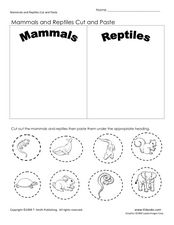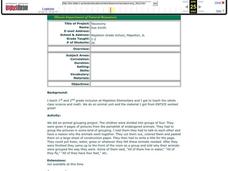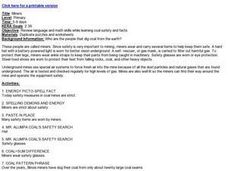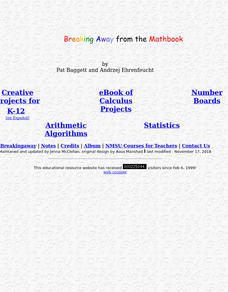T. Smith Publishing
Mammals and Reptiles Cut and Paste
Adorable! Most children are really drawn to animals. With this worksheet, they cut out eight darling drawings of animals and then affix each to a page divided in half according to whether it is a mammal or a reptile. If you need it, an...
Disney
Where Do Brown Bears Live?
What do brown bears in Alaska's Katmai National Park need to survive? Pupils explore the unique habitats, diet, and survival needs of this animal. They predict the consequences of removing any integral part of the bear's survival,...
SF Environment
Sort and Color!
Sorting is a very important skill that can be used in math and even science. Learners get familiar with some environmentally friendly vocabulary terms as they practice separating objects that can be recycled from those that can't. They...
Curated OER
Making a Symmetrical Butterfly
In this math, science, art worksheet, students draw the other side of a butterfly tracing to show symmetry. They trace their own hands four times on colorful paper to make the rest of the butterfly before gluing it altogether.
Curated OER
Dinosaur Pictures: Large to Small
In this ordering by size worksheet, students cut out three pictures of dinosaurs and paste them in order from large to small.
Curated OER
Let's Build
Learners listen as the teacher differentiates between natural and people-made items. They go outside and make lists of natural and people-made things they see. Students complete the linked worksheet by cutting and pasting as suggested by...
Curated OER
Aim-- Use a Carroll Diagram to Sort Animals
In this science activity, students cut out pictures of 12 animals and paste them into the correct space on the Carroll diagram. Students classify animals as living in water or land and with or without legs.
Curated OER
Amazing Transpiration
Learners observe a leaf and discuss the way that water is released from a leaf through its stomata. For this water cycle lesson, young scholars calculate how much water leaves produce from a whole tree.
Curated OER
How does Paper Making Contribute to Economics
Second graders investigate the numerous jobs it takes to create paper in the U.S. In this economics instructional activity, 2nd graders discuss where paper comes from, what types of trees are needed, and how the paper milling...
Curated OER
Weather Report Chart
Students complete a weather report chart after studying weather patterns for a period of time. In this weather report lesson, students measure temperature, precipitation, cloud cover, wind speed, and wind direction for a month. Students...
Curated OER
Logs of Straw: Dendocronology
Students investigate the age of trees by analyzing tree rings. In this dendocronology lesson plan, students examine sample images of tree rings and identify their age by the amount of rings. Students complete a chart...
Curated OER
Garden Tag
Students create mini "gardens" in recycled clothing boxes. They recycle old seed and flower catalogs and "plant" cut-out flowers in their gardens.
Curated OER
Taxonomy
Learners work together to identify groups of endangered animals. Using a pamphlet, they group the pictures according to specific criteria and cut the pictures out and color them. They place the animals in the correct habitat and share...
Curated OER
Miners
Students complete various activities related to mining and mining safety. They write an energy sentence, complete a word puzzle, cut and glue safety equipment on a mining character, solve a math code word puzzle, and complete a maze...
Curated OER
Recycling
Students examine different "cycles" that are found in nature, such as the water cycle and recycling. They create their own artwork about cycles to be displayed on a bulletin board
Curated OER
How Much Does a Bear Weigh?
Students estimate how many children in their class it would take to equal the mass of one adult bear. They then weigh and record their measurement on a chart to check their estimate.
EngageNY
TASC Transition Curriculum: Workshop 9
Here's a workshop for teachers that rocks the academic world! Using earthquakes as a medium for instruction, educators learn about crosscutting engineering with science. Fun, hands-on, collaborative exercises encourage participants to...
Curated OER
Clocks and Time
Students construct clocks and then learn how to read a clock face, tell time, and determine how much time has elapsed.

















